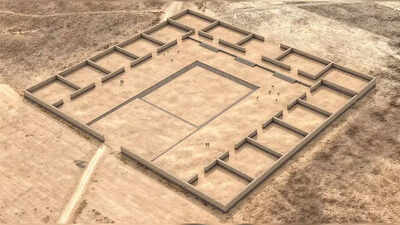ARTICLE AD BOX

Archaeologists have uncovered a 1,000-year-old temple complex in the remote highlands of Bolivia, shedding new light on the Tiwanaku civilization, one of South America’s most influential ancient societies.
Known as Palaspata, the site features massive stone structures, rectangular enclosures, and a central courtyard aligned with the solar equinox. Covering an area roughly the size of a city block, the temple complex indicates highly organized labor and planning, suggesting that it served not only as a ceremonial site but also as a strategic trade hub connecting highland communities with lowland valleys. Carbon dating places its peak activity between AD 630 and 950.
The discovery and significance of the Palaspata temple
Palaspata, located 133 miles southeast of Tiwanaku, had remained hidden from archaeologists despite being known to local Indigenous farmers. Using satellite imaging, drones, and 3D reconstruction techniques, researchers confirmed its geometric layout and man-made structures. The temple’s design, featuring 15 rectangular enclosures around a central courtyard, highlights advanced architectural skills and precise astronomical knowledge.
Experts believe it could have supported a population of over 20,000 people, reflecting the Tiwanaku civilization’s political reach and influence across the region.
A center of trade and ritual
Dr. José Capriles, lead archaeologist from Pennsylvania State University, describes the temple as both a religious and strategic hub. Maize, not locally grown, was transported from Cochabamba valleys, emphasizing the temple’s role in trade and resource distribution.
Excavations also revealed keru cups, used in ceremonial drinking of chicha, indicating that the site hosted agricultural feasts and cultural rituals.
Its alignment with the solar equinox suggests that Palaspata played a significant role in the spiritual and ceremonial calendar of the Tiwanaku people.
Architectural features and artifacts
The site’s perimeter was once marked by red sandstone and white quartzite stones, with some weighing over 100 tons.
Though much of the structure has collapsed, its rectangular layout and central ceremonial courtyard remain visible. Excavations at a nearby smaller site, Ocotavi 1, uncovered homes, tools, animal bones, and human burials with skull shaping, a mark of high social status. Pottery fragments and other artifacts provide further evidence of the civilization’s sophisticated culture and daily life practices.
Technological methods reveal hidden history
Researchers combined satellite imagery with UAV (drone) technology and 3D imaging to uncover the temple’s structure.
Blending multiple images allowed them to detect faint geometric patterns that had gone unnoticed for centuries. These modern techniques highlight the potential of technology in archaeology, enabling the discovery of previously overlooked sites and offering fresh perspectives on ancient civilizations.
Cultural and historical impact
The discovery of Palaspata enriches our understanding of the Tiwanaku civilization, illustrating its architectural, ceremonial, and economic sophistication. Mayor Justo Ventura Guarayo emphasized the importance of the site for local heritage, noting that it connects contemporary communities with their historical roots. Archaeologists believe that continued exploration could uncover further chambers, residential areas, and artifacts, providing deeper insights into the trade networks, rituals, and daily life of this remarkable civilization.



.png)
.png)
.png)
















 1 hour ago
2
1 hour ago
2









 English (US) ·
English (US) ·